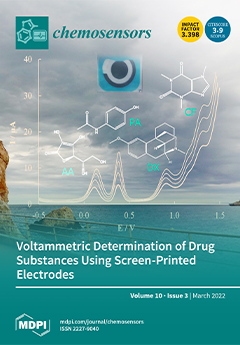In recent years, two-dimensional layered material MXene has attracted extensive attention in the fields of sensors due to its large specific surface area and rich active sites. So, we employed multilayer Ti
3C
2T
X and SnO
2 microspheres to prepare
[...] Read more.
In recent years, two-dimensional layered material MXene has attracted extensive attention in the fields of sensors due to its large specific surface area and rich active sites. So, we employed multilayer Ti
3C
2T
X and SnO
2 microspheres to prepare SnO
2/MXene composites for enhancing gas-sensing properties of pristine SnO
2. The composite was brushed on a microelectromechanical system (MEMS) platform to make resistance-type gas sensors with low power consumption. The gas-sensing results show that the SnO
2/MXene sensor with the best composite ratio (SnO
2: MXene mass ratio is 5:1, named SM-5) greatly improves gas sensitivity of SnO
2 sensor, among which the sensitivity to ethanol gas is the highest. At the same time, the composite also speeds up the response recovery speed of the sensor. When the SM-5 sensor worked at its optimal temperature 230 °C, its response value to 10 ppm ethanol reaches 5.0, which is twice that of the pristine SnO
2 sensor. Its response and recovery time are only 14 s and 26 s, respectively. The sensing mechanism of the composite is discussed according to the classical the space charge or depletion layer model. It is concluded that the Schottky barrier of composites and the metal properties of Ti
3C
2T
x are responsible for improvement of the gas-sensing properties of the composite.
Full article





